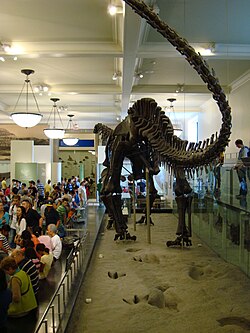Acrocanthosaurus
Acrocanthosaurus was a genus of theropod dinosaur that lived in North America during the Lower Cretaceous period. Its name means "high-spined lizard." This refers to the spines on its vertebrae, which formed a sail or hump when the animal was alive.
| Acrocanthosaurus Temporal range: Lower Cretaceous
125 to 100 mya | |
|---|---|

| |
| Mounted Acrocanthosaurus skeleton at the North Carolina Museum of Natural Sciences. | |
| Scientific classification | |
| Kingdom: | |
| Class: | |
| Superorder: | |
| Order: | |
| Suborder: | |
| Infraorder: | |
| Family: | |
| Genus: | Acrocanthosaurus
|

Its classification is uncertain. It was originally classified as a spinosaur because the spines on its back looked like those of Spinosaurus. However, Acrocanthosaurus is now classified as a carnosaur. Most paleontologists believe that it was a carcharodontosaurid.
Acrocanthosaurus was 38 feet long, almost as large as Tyrannosaurus rex, and weighed about 6 or 7 short tons. It was the largest theropod in North America before the evolution of the tyrannosaurs.[1]
Long, low ridges start at the nasal bones. They run along each side of the snout from the nostril back to the eye, and they continue onto the lacrimal bones.[2] This is a characteristic feature of all allosaurids.[3]
A famous trackway in Paluxy, Texas shows tracks of what might be an Acrocanthosaurus and its prey. While interesting and plausible, this hypothesis is difficult to prove, and other explanations exist.
In popular culture
changeAcrocanthosaurus was featured in an episode of the television documentary Monsters Resurrected. It was depicted as the top predator in early Cretaceous North America. A juvenile was scared away from its kill by a pack of Deinonychus, and was forced to hunt more difficult prey, such as a Sauropelta.
References
change- ↑ Bates, K.T.; et al. (2009). Beckett, Ronald (ed.). "Estimating mass properties of dinosaurs using laser imaging and 3D computer modelling". PLOS ONE. 4 (2): e4532. Bibcode:2009PLoSO...4.4532B. doi:10.1371/journal.pone.0004532. PMC 2639725. PMID 19225569.
We therefore suggest 5750–7250 kg represents a plausible maximum body mass range for this specimen of Acrocanthosaurus.
- ↑ Currie, Philip J.; Carpenter, Kenneth. 2000. A new specimen of Acrocanthosaurus atokensis (Theropoda, Dinosauria) from the Lower Cretaceous Antlers Formation (Lower Cretaceous, Aptian) of Oklahoma, USA. Geodiversitas 22 (2): 207–246.
- ↑ Holtz, Thomas R; Molnar, Ralph E. & Currie, Philip J. 2004. Basal Tetanurae. In Weishampel, David B.; Dodson, Peter; & Osmólska, Halszka (eds) The Dinosauria 2nd ed, Berkeley: University of California Press. pp. 71–110. ISBN 0-520-24209-2